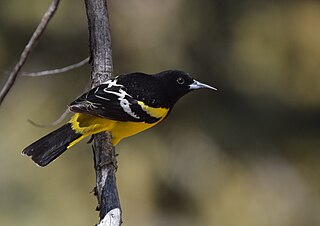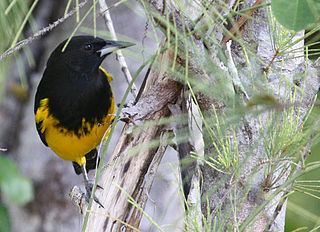
The Altamira oriole is a New World oriole. The bird is widespread in subtropical lowlands of the Mexican Gulf Coast and northern Central America, the Pacific coast and inland. They have since spread to southern Texas, but this was not until 1939.

Cassin's finch is a bird in the finch family, Fringillidae. This species and the other "American rosefinches" are placed in the genus Haemorhous.

The Baltimore oriole is a small icterid blackbird common in eastern North America as a migratory breeding bird. It received its name from the resemblance of the male's colors to those on the coat-of-arms of 17th century Lord Baltimore. Observations of interbreeding between the Baltimore oriole and the western Bullock's oriole, Icterus bullockii, led to both being classified as a single species, called the northern oriole, from 1973 to 1995. Research by James Rising, a professor of zoology at the University of Toronto, and others showed that the two birds actually did not interbreed significantly.

Bullock's oriole is a small New World blackbird. At one time, this species and the Baltimore oriole were considered to be a single species, the northern oriole. This bird is named after William Bullock, an English amateur naturalist.

The orchard oriole is the smallest species of icterid. The subspecies of the Caribbean coast of Mexico, I. s. fuertesi, is sometimes considered a separate species, the ochre oriole or Fuertes's oriole.

The Scott's oriole is a medium-sized icterid.

The rufous-crowned sparrow is a small American sparrow. This passerine is primarily found across the Southwestern United States and much of the interior of Mexico, south to the transverse mountain range, and to the Pacific coast to the southwest of the transverse range. Its distribution is patchy, with populations often being isolated from each other. Twelve subspecies are generally recognized, though up to eighteen have been suggested. This bird has a brown back with darker streaks and gray underparts. The crown is rufous, and the face and supercilium are gray with a brown or rufous streak extending from each eye and a thick black malar streak.

The yellow-tailed oriole is a passerine bird in the New World family Icteridae. It breeds from southern Mexico to western Peru and northwestern Venezuela; in Peru it also lives in a river valley corridor.

The yellow-green vireo is a small American passerine bird. It is migratory breeding from Mexico to Panama and wintering in the northern and eastern Andes and the western Amazon Basin.

The Montserrat oriole is a medium-sized black-and-yellow icterid.

Audubon's oriole, formerly known as the black-headed oriole, is a New World passerine inhabiting the forests and thickets of southeastern Texas and the Mexican coast. It is the only species to have a black hood and yellow body. It is divided into four subspecies and two allopatric breeding ranges. The westernmost range extends from Nayarit south to southern Oaxaca, whereas the eastern range stretches from the lower Rio Grande valley to northern Querétaro. The most common in the western range are the subspecies I. g. dickeyae and I. g. nayaritensis; I. g. graduacauda and I. g. audubonii can be found in the eastern range. Like most Central American birds, it is not a migratory species and does not display significant sexual dimorphism. DNA analysis of the ND2 and cyt-b genes strongly suggests that I. graduacauda is most closely related to I. chrysater, the yellow-backed oriole. It is a member of the genus Icterus and therefore should not be confused with the Old World orioles.

The black-backed oriole is a species of bird in the family Icteridae. It is endemic to Mexico. Its natural habitats are subtropical or tropical moist lowland forest and subtropical or tropical moist montane forest, but it is also found in cities. It is one of the few species that can consume monarch butterflies due to evolving a tolerance to their natural poison.

The yellow-backed oriole is a species of bird in the family Icteridae.

The white-edged oriole is a species of bird in the family Icteridae. It is found in Ecuador and Peru.

The campo troupial or campo oriole is a species of bird in the family Icteridae that is found in northeastern Brazil. At one time thought to be conspecific with the Venezuelan troupial and orange-backed troupial, it is now accepted as a separate species. It is a fairly common bird and the International Union for Conservation of Nature has rated it as a "least-concern species".

The spot-breasted oriole is a species of bird in the family Icteridae.

The black-cowled oriole is a species of bird in the family Icteridae. It is common and widespread in the Caribbean lowlands and foothills from southern Mexico to western Panama. It lives primarily in humid or semihumid forest, as well as in clearings, along forest edges, in plantations, in semi-open areas with scattered trees and bushes, and in gardens. The adult male is black, with yellow on the belly, shoulder, rump, wing lining, and crissum. The female's plumage varies depending on location. In the south of its range, it is similar to that of the male. In the north, its crown and upperparts are olive-yellow, while its face, throat, upper breast, wings, and tail are black.

The black-vented oriole is a species of bird in the family Icteridae. It is found in El Salvador, Guatemala, Honduras, Mexico, Nicaragua, and the United States.

The orange-backed troupial is a species of bird in the family Icteridae. It is found in Guyana, Brazil, Paraguay, and eastern Ecuador, Bolivia, and Peru. It is closely related to the Venezuelan troupial and Campo troupial, and at one time, all three were considered to be the same species.

The Bahama oriole is a species of songbird in the New World blackbird family - Icteridae. It is endemic to the Bahamas. It is listed as critically endangered by the IUCN (CR). The taxon was originally classified as its own distinct species in 1890 by Joel Asaph Allen before it was lumped with the Cuban oriole, Hispaniolan oriole, and Puerto Rican oriole into a single species by the ornithologist James Bond in his book "Birds of the West Indies". It wasn't until 2010 that all four birds were again elevated to full species status based on a combination of evidence from DNA, plumage and song. Since it was not recognized as a distinct species for so long, the Bahama oriole's preferred non-breeding season habitat is unknown and current estimates of its exact numbers remain vague.























